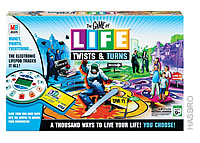A Skewed Take on Life
The classic board game gets a cashless makeover, denying children an opportunity to learn how to manage hard currency.

Say it ain't so, Hasbro! Recently, the toy manufacturer announced that later this year it will launch a new edition of its venerable classic, The Game of Life. The new version, called Twists & Turns ($35), will replace play money with a Visa-branded card. Players insert their cards into a gizmo, called a LIFEPod, that keeps track of each player's finances so there's no need for a banker.
As Matt Collins, Hasbro's vice-president of marketing, explains, "We knew it was time to reflect the way people choose to pay and be paid -- and replacing cash with Visa was an obvious choice."

Well, it's not obvious to me. I'm a big proponent of using board games to teach children about money, and the classic Game of Life has always been a family favorite. It covers a lot of territory: careers, college, mortgages, insurance, taxes, stocks and dividends. And it lets kids feel the pleasure of collecting a salary, or the pain of paying for college, by piling up or depleting their stacks of money.
From just $107.88 $24.99 for Kiplinger Personal Finance
Become a smarter, better informed investor. Subscribe from just $107.88 $24.99, plus get up to 4 Special Issues

Sign up for Kiplinger’s Free Newsletters
Profit and prosper with the best of expert advice on investing, taxes, retirement, personal finance and more - straight to your e-mail.
Profit and prosper with the best of expert advice - straight to your e-mail.
Plus, the player who's designated to be the banker has to count out each player's cash, pay salaries, collect fines and make change -- a painless way for kids to hone their math skills.
For all those reasons, using a card just doesn't cut it -- especially when that card is advertising a company's logo to 9-year-olds, the game's target audience. And -- yikes! -- Monopoly may be next. Hasbro has already introduced a cashless version of the game in the United Kingdom.
The adults who dream up these things say they're just trying to prepare kids for a cashless society. But they make the mistake of thinking like grown-ups instead of children.
A cashless society may be a great thing for credit-card issuers, online retailers and adults who use plastic as a convenience. But kids see the world in more concrete terms. Although the Visa Life card isn't labeled a credit card or a debit card or a prepaid card, the distinction is lost on youngsters.
To kids, plastic of any kind isn't as real as money they can see and feel. With a cashless society looming in their future, teaching children to manage hard currency is more important than ever.
Readers of this column know that I've been on this crusade for a long time. Two years ago I wrote that giving kids credit cards is like letting them use drugs early so they won't turn into addicts (see Kids and Credit Cards Don't Mix).
But I'm not alone on my soapbox. There's plenty of research to back me up, and I'll write more about that next week.
Next: Credit Cards Not a Game
Profit and prosper with the best of Kiplinger's advice on investing, taxes, retirement, personal finance and much more. Delivered daily. Enter your email in the box and click Sign Me Up.

Janet Bodnar is editor-at-large of Kiplinger's Personal Finance, a position she assumed after retiring as editor of the magazine after eight years at the helm. She is a nationally recognized expert on the subjects of women and money, children's and family finances, and financial literacy. She is the author of two books, Money Smart Women and Raising Money Smart Kids. As editor-at-large, she writes two popular columns for Kiplinger, "Money Smart Women" and "Living in Retirement." Bodnar is a graduate of St. Bonaventure University and is a member of its Board of Trustees. She received her master's degree from Columbia University, where she was also a Knight-Bagehot Fellow in Business and Economics Journalism.
-
 Tip: Ways to Track Your Credit Card Rewards
Tip: Ways to Track Your Credit Card RewardsHere are the best strategies and apps to help you stay current with your credit card rewards.
-
 How New Investors Can Pick Their Perfect Portfolio, According to a Pro
How New Investors Can Pick Their Perfect Portfolio, According to a ProSee what Cullen Roche has to say about finding your perfect portfolio as a new investor and his two-word answer on where he thinks the stock market is headed in 2026.
-
 HNW Retirees: Don't Overlook The Benefits of Social Security
HNW Retirees: Don't Overlook The Benefits of Social SecurityWealthy retirees often overlook Social Security. But timed properly, it can drive tax efficiency, keep Medicare costs in check and strengthen your legacy.
-
 Smart Strategies for Paying Your Child an Allowance
Smart Strategies for Paying Your Child an AllowanceBy giving your kids money to spend and save, you’ll help them sharpen their financial skills at an early age.
-
 How to Motivate Kids to Save
How to Motivate Kids to Savepersonal finance It's not easy teaching your child to save. Here are some ways readers have incentivized their kids to keep track of their finances.
-
 Lessons for Kids From the Crisis
Lessons for Kids From the Crisissavings One of the greatest opportunities presented by the pandemic is to give children an appreciation for the workings of the economy.
-
 Why Financial Education Works
Why Financial Education Workscollege Money skills learned young will pay off in the long run.
-
 The Tooth Fairy Is Leaving Less Under Pillows These Days
The Tooth Fairy Is Leaving Less Under Pillows These Dayssavings The average amount that the Tooth Fairy gives kids is down 10% from last year.
-
 The Value Test: 300 Colleges That Pass
The Value Test: 300 Colleges That PassCollege Rankings All the schools on our list, from 1 to 300, are best values.
-
 6 Ways to Get Your Kids to Do Chores Without Paying Them
6 Ways to Get Your Kids to Do Chores Without Paying Themspending Kids shouldn't be paid for doing routine tasks, but for doing extra jobs that parents define as above and beyond.
-
 Save $1 for College, Cut $2 in Debt
Save $1 for College, Cut $2 in Debtcollege Paying for college doesn't mean you have to take out thousands in student loans.